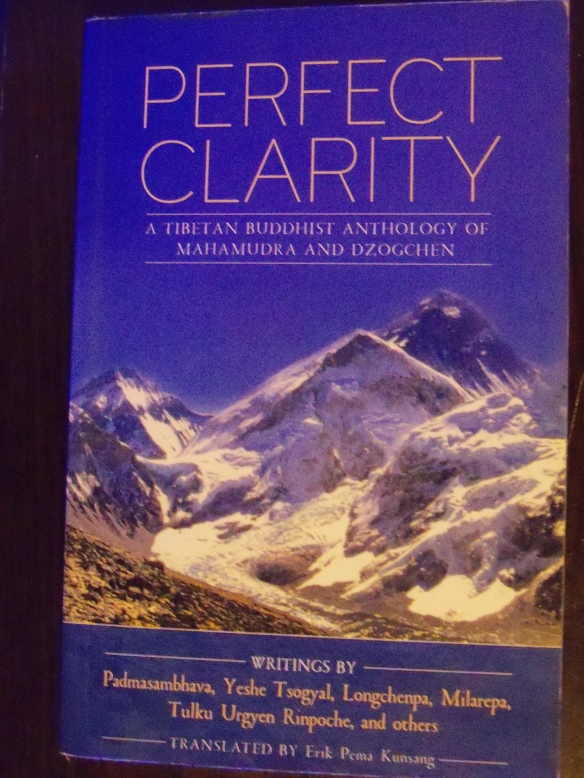
Perfect Clarity is the work of a small team of practitioners and scholars associated with a Dzogchen teaching lineage begun in the 19th Century, and now centrally based in Nepal but with centers spread in various locales worldwide. In fact, in Mendocino County of California, where I live, there is one such “Gomde” or teaching and retreat center along the south fork of the Eel River.
The works translated by Eric Pema Kunsang, and compiled and edited by Michael Tweed and Marcia Schmidt (she also wrote the preface), date back to Padmasambhava and Yeshe Tsogyal (his yogini consort) up through the 19th Century when masters revealed what was represented by them as the exposure of past ancient teachings hidden by figures like Padmasambhava. These later time revealers of the “treasure” of past teachings that were kept underground, or non public (until for better or more fruitful times), would either retrieve the teachings from hidden locations like caves or from the “mindstream” of past teachers (like disciples of Padmasambhava and others of his time and later) now reincarnated as the current finder of the teaching.
This is an anthology of “pithy” meditation instructions by masters from the mahamudra and dzogchen traditions emerging from Tibet, which had absorbed in the 8th and later centuries the growing Tantra traditions of northern India.
A brief statement by the late Tulku Urgyen Rinpoche, “an introduction to guidance manuals”, notes that the types of short texts found in this book were based on oral instructions and contained everything a practitioner needed. BUT, he emphasizes that the actual guidance from a human teacher is essential for most people in order to clarify. Also, the energy of devotion and resulting opening up, he says, is much more important than scholarship.
Excerpt from that statement:
“In this dark age, the most effective style of teaching is not lengthy, scholarly explanations but rather direct guidance manuals. The dzogchen tantras themselves were written in a style that shrouds and conceals the meaning so only a master who is extremely well versed in oral instructions and treaties is able to clarify them. Conversely, based upon oral instructions a guidance manual is a short, comprehensive teaching written in a clear and simple manner. Such summaries contain all the teachings that a worthy practitioner requires to reach the state of primordial enlightenment in this very life.”
“Perfect Clarity” organizes the instructions from various Masters in four categories, “Supplications”, “Mahamudra”, “Dzogchen”, and “Unity”. There are 22 short and concise writings. I will briefly share notes from two of them. But, first this quote by Tsele Natsok Rangdrol, offered on the page preceding the table of contents:
“Mahamudra and dzogchen
Differ in words but not in meaning.
The only difference is that mahamudra stresses mindfulness,
While dzogchen relaxes within awareness.”
~Mipham Rinpoche (146-1912): “The Instruction on Stillness, Occurrence, and Awareness in Mahamudra”.
Stillness state of no thought.
Occurrence “when various kinds of thoughts arise”.
Awareness is being conscious of either of these states.
Being mindful of these two states, “you will come to understand the following vital point: Various feelings such as joy and sadness arise from your mind and dissolve back into your own mind….”
And, “by looking directly into the essence of your mind, whether it is still or thinking, you will understand that it is empty and, even though it perceives many things, it does not possess any entity whatsoever. This so-called emptiness is not a blank void like space….[It] is an emptiness endowed with all supreme aspects…[It has an unceasing clarity that is fully conscious and cognizant.
“When realizing this secret point, although there is no separate watcher or something watched, to experience the naturally luminous and innate mind-essence is known as recognizing awareness. This is what is pointed out in both mahamudra and dzogchen.”
“There is nothing easier than this, but it is essential to practice.”
~Chokgyur Lingpa (1829-1870) “The Instruction Manual for the Ground of Trekcho”.
Meditation instruction on the “ground of cutting through”, “the natural state” in accordance with the “secret practice” of dzogchen.
Preliminaries to instruction performed. Then Master instructs:
Assume “the sevenfold posture of Vairochana”. (My note: probably important just to emphasize a comfortable sitting position, conducive to being relaxed but alert, and keeping the back straight.)
“Let the non arising nature of your mind—-this empty and luminous awareness, this primordially pure and spontaneously present essence—remain in the state of fourfold resting of body, speech, and mind. Don’t pursue what has passed before, don’t invite what hasn’t occurred, and don’t construct present cognizance.”
Fourfold resting: rest the body; rest voice in state of stillness; rest eyes “without blinking, in a continuous, focused gaze”; rest the mind “quietly in the unfabricated and spontaneously present state of the empty and luminous nature of awareness”. Rest free from thought.
“…[To] rest in the state of empty and luminous awareness is known as the ground of cutting through”.
At this point, the instructions dovetail with the instructions given above by Mipham Rinpoche (in the first set of notes): “Now, as for the mingling stillness and thinking: stillness is to rest quietly in the state of empty and luminous mind-nature. From within that state a thought suddenly occurs. By looking directly into it, it completely disappears in the continuity of the mind-nature”.
